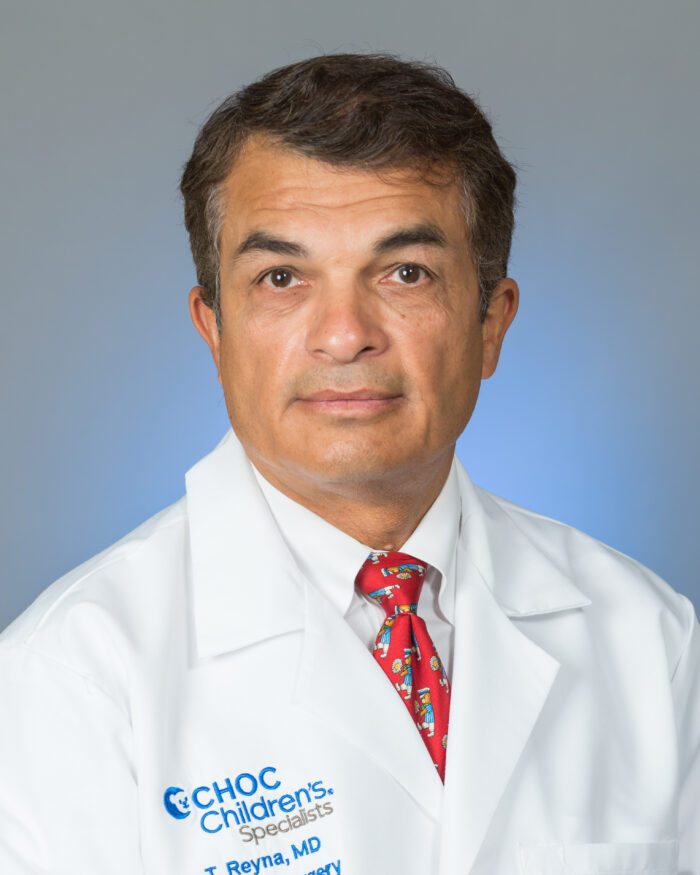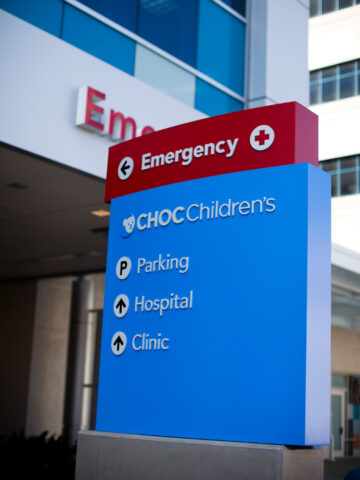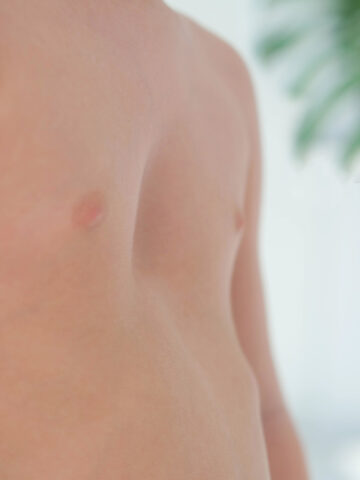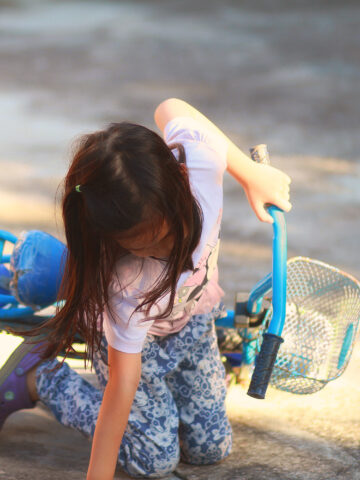Dr. Troy Reyna, pediatric general and thoracic surgeon at CHOC, has vast experience in performing innovative treatments for Hirschsprung’s disease, pectus excavatum and hernias. However, Dr. Reyna considers hyperhidrosis surgeries among his most fulfilling work.

“A hyperhidrosis surgery can radically change a patient’s physical and functional life,” he says.
In a recent talk for CHOC’s Grand Rounds, Dr. Reyna gave advice to community pediatric physicians on the symptoms, referral process and treatments for hyperhidrosis.
Hyperhidrosis signs and symptoms in children
Hyperhidrosis is an excess of sympathetic discharge that affects and can increase the sweating of hands, feet, axilla and other areas, says Dr. Reyna.
Hyperhidrosis incidence and characteristics include:
- 2.8% of the population is affected.
- Symptoms must be present for greater than 6 months for a diagnosis.
- Typical age of onset is less than 25 years.
- Bilateral presentation – typically present in both hands, both feet and both axilla.
- There can be a history of “triggers” like watching a scary movie, fear of talking in front of people, and other emotional and stressful experiences.
- There is an apparent genetic link – one of the parents may have it to a lesser degree, which may hinder the access of the child to definitive care.
There are two types of hyperhidrosis: primary and secondary, says Dr. Reyna.
Primary hyperhidrosis:
- Occurs in patients younger than 25 years.
- 30 to 50% of cases are linked to genetic history.
- Affected areas include the axilla (50%), soles (30%), palms (25%) and face (2%).
- Causes increased daytime sweating.
- Includes no sweating at night during sleep.
- Includes triggers such as emotion, stress, changes in temperature
- Has an onset of symptoms usually in adolescence or earlier. In adolescence, the symptoms may have increased negativity due to the significance of social and personality skill development.
Secondary hyperhidrosis:
- Occurs in older patients.
- Is not genetic.
- Has symptoms that can manifest during sleep
- Can be associated with systemic disease like proliferation, infections, cardiac disease, metabolic disorders and some types of cancer.
- Can be caused by medications like opioids, cyclooxygenase inhibitors, antibiotics, antidepressants or blood pressure medications.
Primary hyperhidrosis can put a social and emotional burden on children and adolescents even from a young age, says Dr. Reyna. It may cause:
- Anxiety.
- Depression because they are told that sweating is “normal” or that there is “nothing that can be done.”
- All aspects of quality of life – physical, functional, social and emotional – to be affected. For example:
- A high school tennis player that can’t hold onto their racquet during games.
- A high school baseball player that must change gloves after every inning.
- A school-age child is embarrassed to turn in their homework because they can’t hold the pencil, or their paper is stained and wet with sweat.
Additionally, hyperhidrosis gets worse with age because of the awareness and significance of the symptoms. Once the child is in high school, it may severely affect their social and emotional lives.
Treatments for hyperhidrosis
The severity of hyperhidrosis exists on a spectrum; cases may be mild, moderate or severe.
For pediatricians that see patients with mild or moderate symptoms of hyperhidrosis, I advise them to first refer them to a pediatric dermatologist to try some of the frontline treatments like antiperspirants, iontophoresis or robinul pills. All these options are less invasive than surgery.
Possible treatments that may help mild or moderate cases of hyperhidrosis include the following, says Dr. Reyna:
Aluminum chloride antiperspirants
Aluminum chloride antiperspirants – topical, frontline medications – prevent sweating by mechanically blocking the sweat glands. They are applied only to dry skin at night before the child goes to bed. Unfortunately, these treatments can cause side effects such as skin irritation.
Glycopyrronium
Glycopyrronim, which is a glycoprotein, has just been approved by the FDA for treating underarm and palm sweating. This is a longer-acting medication that works to block a certain natural substance that causes the glands to produce sweat. It comes in the form of an individually sealed wipe which is applied and used daily.
Just as with aluminum chloride, rashes and irritation can be evident with chronic use, which may negate the efficacy or the usage of this medication.
Iontophoresis
Iontophoresis is a rather unique, ingenious therapy of using an electrical current to depolarize the sweat glands and reduce the production of sweat in the axilla, hands or feet, says Dr. Reyna.
It is a device that has a low-voltage current that goes through a plate. The plate sits in a base of tap water with sodium hydroxide or electrolyte solution. With it, it is thought that the skin is either thickened or the nerve endings are depolarized to prevent the production of sweat.
It must be done every day and can take 10 to 30 minutes to apply, he says. Effects are temporary and must be repeated regularly. Some patients may be able to use it a few days a week, but in severe cases, it must be used daily. The treatment is time-consuming, but the devices are inexpensive and readily available online.
The results of this treatment are still being determined, says De. Reyna. So far, there is mixed efficacy for usage, time and compliance.
miraDry
miraDry is a new treatment for axillary hyperhidrosis. It destroys the sweat glands with thermal radiation like a microwave. The treatment relieves sweat, reduces body odor and can remove underarm hair follicles. Dermatologists perform the treatment and it’s not typically covered by insurance, says Dr. Reyna. The treatment cost may range between $2,500 to 4,000, and once it’s done, it’s permanent and extremely effective.
Hyperhidrosis medications
Botuilnum toxin
Botuilum toxin can be time-consuming and painful with medication being injected on multiple sites in hands or feet, says Dr. Reyna. The effects are temporary and must be repeated every 90 days. Injections are often painful for pediatric patients.
“Many of my patients decide there must be something better,” he says.
Other hyperhidrosis medications
- Glycopyrrolate – an anticholinergic medication that blocks the sweat glands. Side effects may include dry cotton mouth or dizziness in children.
- Clonidine – an antidepressant can be used to reduce sweating but has a lot of side effects.
- Calcium channel blockers – have had mild success.
For any of these medications, compliance is key. They must be used daily to make changes, notes Dr. Reyna.
Endoscopic thoracic sympathectomy
Endoscopic thoracic sympathectomy (ETS) is a surgical treatment for palmar hyperhidrosis; this treatment is the last resort for pediatric patients when other methods have failed or noxious side effects of medical management are present.
“Dermatologists will refer patients to me that don’t have success with topical treatments,” says Dr. Reyna.
Endoscopic thoracic sympathectomy characteristics:
- Requires general anesthesia.
- It is instantaneously effective – the patient’s hands will be dry in the recovery room.
- Compensatory sweating risk is 30 to 40%.
- Procedure is done as an outpatient in most cases.
- Patient satisfaction rate is over 95%.
ETS surgical process
To treat palmar hyperhidrosis, the portion of the sympathetic chain that stimulates the sweat glands to the hands are resected, says Dr. Reyna. This portion is located between the bottom of the second rib and the top of the fourth rib. Here, there are ancillary fibers which are called the nerve fibers of Kuntz. There, a wide excision of the pleura extending onto the rib is needed to get the most effective result with respect to treating the patient’s sweaty palms.
For the surgery, the patient’s positioning on the table should be supine, he adds. There will be two ports — one for the camera to visualize the sympathetic chain and one for electrocautery.
Meanwhile, a double-lumen endotracheal tube allows the anesthesiologist to ventilate through the contralateral side. This provides good visibility to the sympathetic chain because the lung is nicely compressed and does not get in the way.
The electrocautery allows the incision — utilizing an electric current — of the pleura overlying the sympathetic chain. The sympathetic chain from the third rib is to be sectioned and coagulated along with some of the adjacent pleura to account for the accessory nerves.
“The incisions heal quite nicely, I haven’t had any of my patient complaints about the position or the visibility of them following surgery,” says Dr. Reyna.
The main side effect of this surgery is compensatory sweating. Unfortunately, when you restrict certain sympathetic flow, such as to the hands, there can be increased flow to other areas of the body. However, compensatory sweating is much more tolerable for many patients.
About 50 to 60% of patients can go home the same day.
“As you can imagine, because of the degree to which palmar hyperhidrosis affects patients, the surgery’s satisfaction rate is extremely high. It’s 95% or greater. And as I mentioned early on, the satisfaction rate for the surgeon, myself, is also extremely high,” says Dr. Reyna.
Refer a patient to pediatric general and thoracic surgery at CHOC




